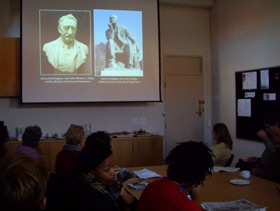The Rhodes less travelled

In her presentation, Schmahmann told of how Rhodes University and the University of Cape Town each acquired keynote sculpted portraits of Cecil John Rhodes in the early twentieth century. She went on to explore the circumstances surrounding the acquisition of the two works and how they have been negotiated in a post-apartheid context.
'A marble bust of Rhodes by Henry Pegram, acquired by Rhodes University College (which later became Rhodes University) in 1907, was displayed in such a way that the university not only revealed its imperialist beliefs but also created the impression that it had been founded as the outcome of the mining magnate's wishes,' said Schmahmann, a Professor in the Fine Art Department at Rhodes University.
Yet the sculpture's unceremonious sequestering in a storage cupboard in the Economics Department the late 1990s was not, she pointed out, motivated by transformative agendas, and was instead - paradoxically - part of an endeavour to counter arguments about a pressing need to rename the institution. 'There appears in fact to be uncertainty on the part of Rhodes University about how to manage a connection to the historical figure of Cecil Rhodes which it had forged carefully since its founding but which no longer served its interests in a post-apartheid context.'
Meanwhile, she said, a portion of land from Rhodes' Groote Schuur estate was allocated for the establishment of the primary campus of the University of Cape Town, and the buildings were ready for occupation in 1928. A bronze sculpture of Cecil Rhodes by Marion Walgate, paid for by the Rhodes National South African Memorial Committee and completed in 1934, was originally positioned at a lower point of the campus than where it is currently. Relocated to its current location in 1962, it provided the magnate with 'an especially lofty vision of his domain'.
'But rather than signifying antagonism to transformative initiatives or encouraging single-minded admiration for Cecil Rhodes and his legacy, the retention of the sculpture in this prominent position has provided a forum for some critical engagements with institutional histories and a public art inheritance,' argued Schmahmann. She conceded that not all engagements with the work have been equally sophisticated, but argued that the sculpture's presence on campus 'presents members of the institution with opportunities to enrich their own understandings of complex histories and to strive for the creation of a democratic future'.
'Many would now regard art objects, which resulted from the influence of British imperialism as somewhat troublesome inheritances, but I would argue that simply placing them in storage and relegating them to the closet is not necessarily an appropriate way of dealing with such objects,' said Schmahmann. 'Those rooting for the removal of artworks do not always necessarily have transformative agendas in mind. In the paradoxical world of public art, steps taken in regard to such sculptures are not always what they might seem, and the hiding away of an object can, in fact, suppress oppositional viewpoints and thus counter transformative agendas.
'On the other hand, leaving an object where it is sometimes provides a locus for helpful critical engagement. Exposing an institution's past via an art object can be conducive towards developing in viewers a commitment towards justice and equal opportunity.'
An art historian with an interest in gender, women's community projects as well as public culture, Schmahmann has authored articles, books and essays, and has curated two travelling exhibitions. Her book, Through the Looking Glass: Representations of Self by South African Women Artists, won the Vice-Chancellor's Book Award 2007. The chair of a working group at Rhodes University tasked with developing policies for the management of visual culture on campus as well as commissioning work for the council chamber, she is currently working on a book provisionally entitled Reframing visual culture at universities in post-apartheid South Africa.